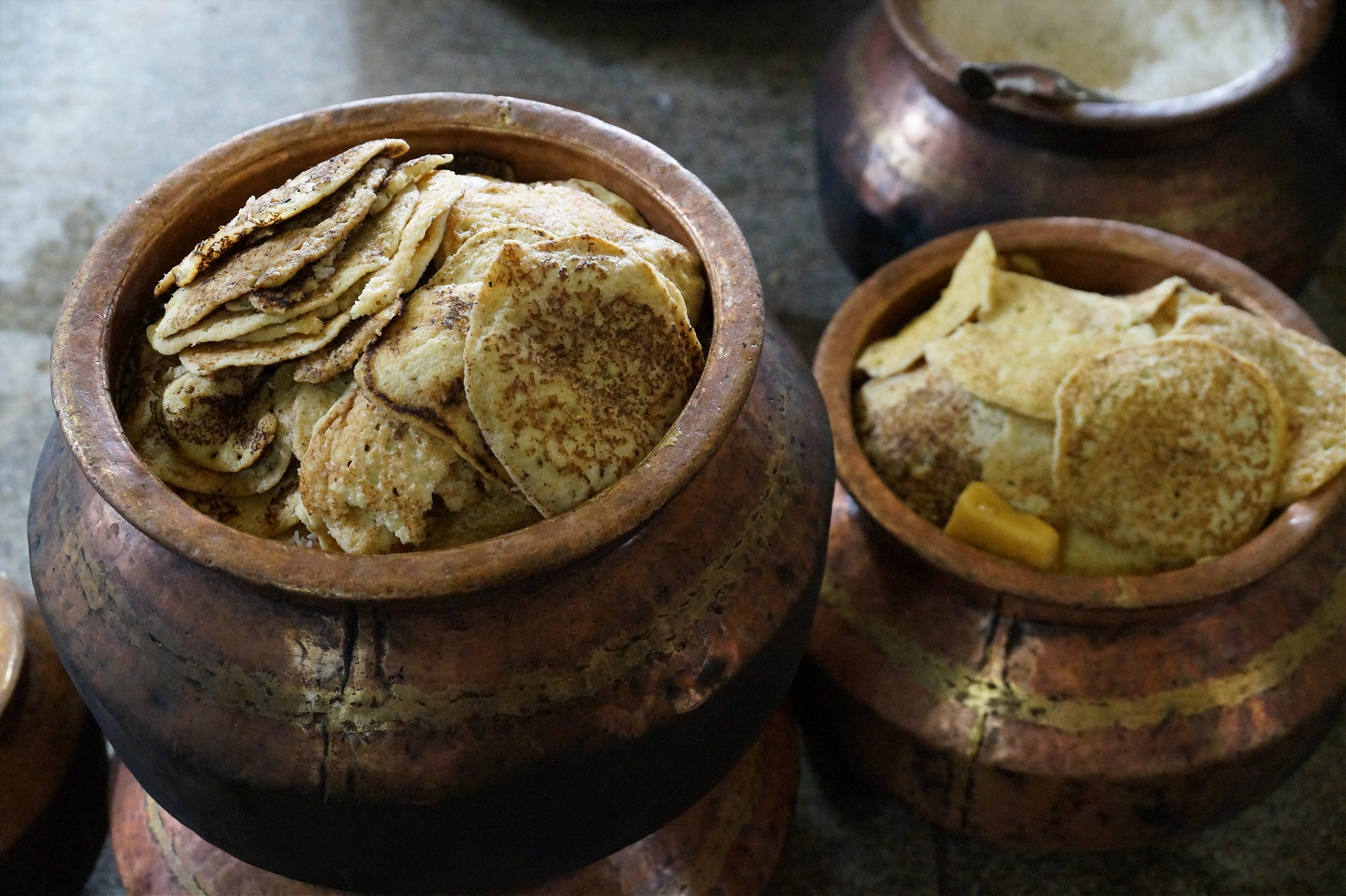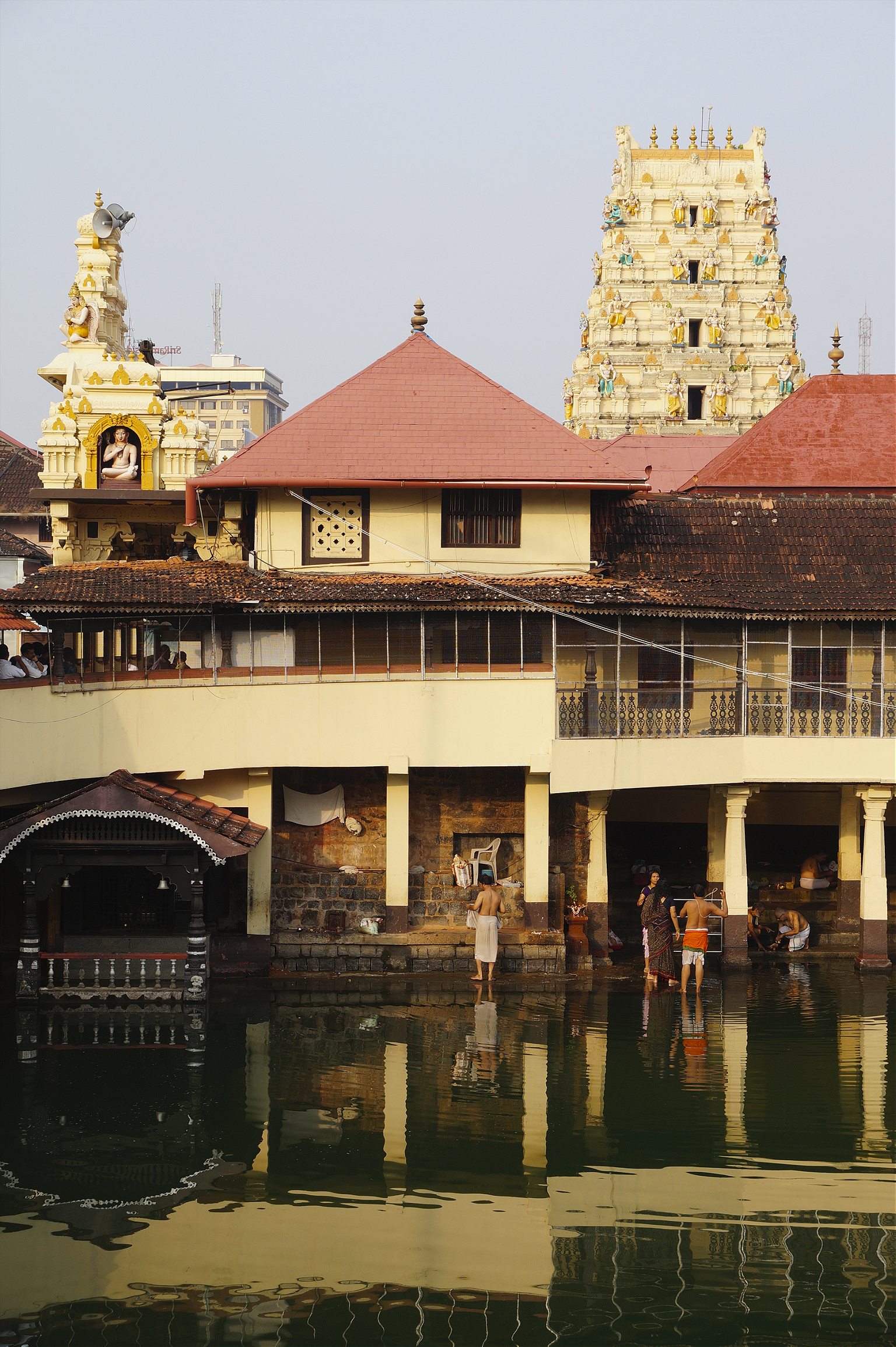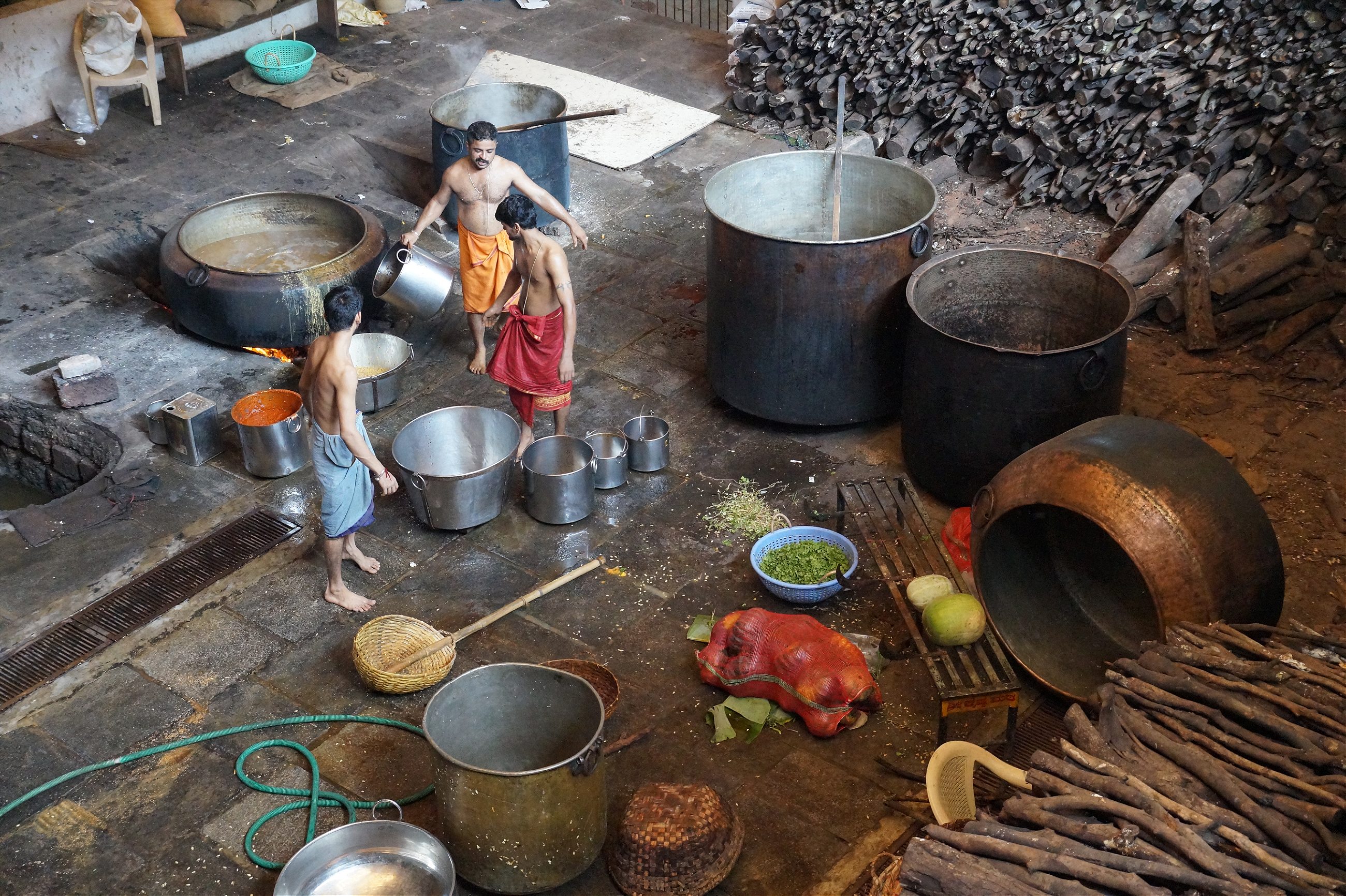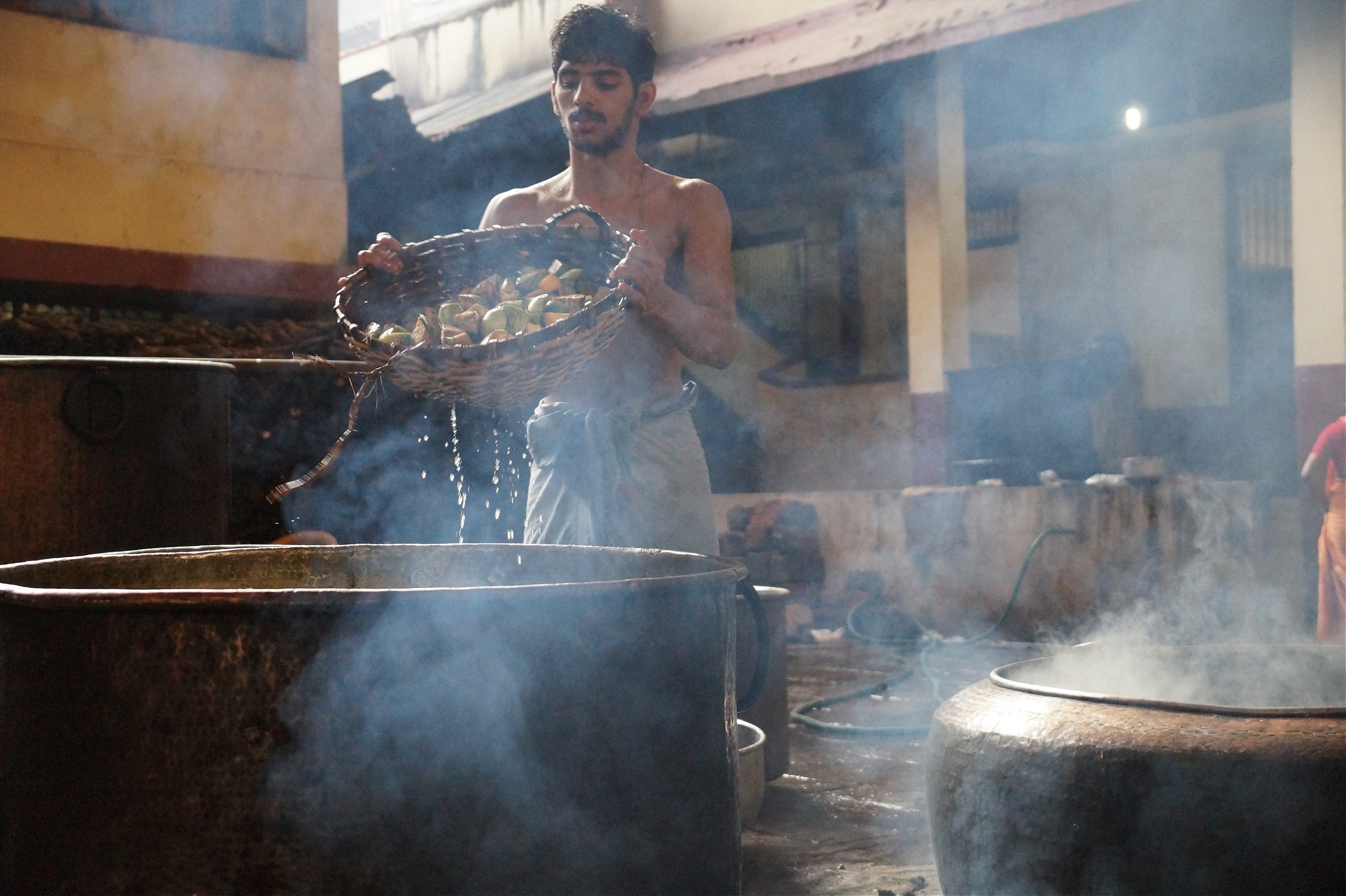Udupi cuisine’s democratizing journey from holy kitchens to Mumbai canteens.
My favorite place to eat in Mumbai is A. Rama Nayak’s Udupi Sri Krishna Boarding, a real mouthful of a name for a simple place. Set in a leafy South Indian enclave called King’s Circle, Rama Nayak’s occupies a pair of bright, breezy rooms up a flight of stairs in a nondescript building next to the Matunga Central railway station. Crowded, Formica-topped tables flank narrow aisles patrolled by a small army of lungi-clad kitchen attendants who ladle food relentlessly from small metal pails onto banana-leaf plates until you tell them to please-god-stop.
The food is simple, unchanged since the restaurant first opened its doors in 1942. Set lunches and dinners rotate through the week. You’ll get chutneys and bright-red mango pickle and a little mound of salt; three vegetables (chickpeas in a creamy, coconut gravy, turmeric-stained kohlrabi lightly fried with fresh shredded coconut, a sweet-and-savory curry made from gems of ripe mango, etc.); a South Indian lentil dish called sambar; a soup called rasam, soured on alternating days with tomato or tamarind or kokam (a dry coastal berry); and the obligatory heaps of rice, drizzled, if you like, with ghee. Heavy on coconut and aromatic curry leaf, light on heat and oil, the food is healthy and plentiful and astonishingly cheap. An unlimited, catatonia-inducing meal costs rs.140, about two dollars.
The restaurant’s founder and namesake, A. Rama Nayak, came to Bombay in the 1930s, an 11-year-old pauper of high-caste, Brahmin stock from the temple town of Udupi, some 800 miles down the Arabian Sea coast. He landed a job as a kitchen boy at the city’s Ram Krishna Mission, and within a decade he’d garnered enough experience and capital to open his own place in what was then a neighborhood occupied principally by poor migrants from the south. He designed his menu to provide succor of both the physical and spiritual sort: two square meals a day and a taste of home for anyone who needed it.
When my grandfather came here, there were no Udupis.
One balmy October morning, I met with Shashant Nayak, who in 2009 left a job in marketing to run his grandfather’s restaurant. “When my grandfather came here, there were no Udupis. There were North Indian places and Irani Cafes”—affordable corner shops opened by late-19th-century Persian immigrants, the first democratic dining institutions in India—“but we needed to identify as something else,” he said.
In the seven centuries before Nayak came to Bombay, his native town had become famous for the daily mass feedings held at its celebrated Krishna temple. The name Udupi, associated closely with a strict tradition of ritual purity, promised scrupulous attention to cleanliness, a neutral dining space acceptable for patrons of any caste. Nayak, as the sign at the restaurant’s entrance proudly proclaims, was Mumbai’s “introducer of Udipi style hotels.” (Hotels, in Indian parlance, refer to an inexpensive canteen.) By the 1970s, the city was flooded with them.
Unlike Rama Nayak’s, most of Mumbai’s Udupis focused on the rice-based ‘tiffin’ snacks that are the staples of India’s peninsular south. There are crisp, golden dosas; steamed, saucer-shaped idlis; airy, deep-fried vade; and pancake-like uttappam studded with onion and tomato, all made from fermented batters of ground rice and lentils. Today, it’s not uncommon for people in Mumbai to assume that these dishes originated in Udupi. In reality, as the owner of one King’s Circle establishment tells me, “these rice-based items are staples all over the south. We made them ‘Udupi’ later.”

I’d lived in Mumbai for six months before I first went to any of the King’s Circle Udupis, and a solid year before I found my way up the stairs to Rama Nayak’s at the suggestion of a local friend who’d spent his college days eating and smoking joints around the neighborhood. On one of my first visits there, maybe three years back, I made the mistake of bringing a magazine with me, which I often do when eating alone, and was startled a few minutes into my meal when an officious bald man slammed his palm onto the table in front of me. “Do one thing at one time,” he commanded. Chastened, I put the magazine away.
By the time I sat down to chat with Shashant, I’d long since become a regular (and stopped bringing reading material). Rama Nayak’s had become the place I brought people when I wanted to make an impression, when I wanted to show a different form of Indian cookery in a place that captured the very best of my adoptive city’s cosmopolitan, if mildewed, soul.
When I told him about my chastening, we both laugh. “When you’re eating, your mind should not be distracted,” he explained. Then, suddenly quite serious, he added: “In our place, food is considered as God.”
For the last 800 years, since the 13th century Hindu Saint Madhvacharya recovered an image of the mischievous boy-god Krishna from a block of clay washed up on a nearby beach, a retinue of priests from the Shivalli Brahmin caste—a subsection of the priestly caste, the highest in traditional Hindu society—has spent the better part of each day cooking for Udupi’s patron deity and distributing free food to all passing pilgrims. In his incarnation at Udupi, Krishna is known as Anna Brahma, God of Food.
In the last five centuries, the temple’s daily ritual ceremonies, or pujas, have multiplied to a staggering fourteen, and the number of pilgrims to feed has swelled to 5,000 on the quietest day (on festival days, the temple kitchens will feed as many as 100,000). On an average day, the temple kitchens run through 2,650 pounds of vegetables and 7,700 pounds of rice. According to one of the temple administrators, there’s a single donor from Chennai, South India’s largest city, who contributes rs.200,000—roughly $3,000—each month just to keep the temple in ghee.
Throughout the course of the morning, beginning with the first puja at 5 a.m., Krishna receives bananas and sweets; milk and curd; puffed rice, dosai, and a sweet rice-and-milk porridge called payasam. At the afternoon Mahapuja, the largest ceremony of the day, he’ll get fifteen different dishes—sweets and salads, fruit and vegetable curries, and five varieties of spiced or flavored rice. At each puja, he’ll also receive an immense copper vessel filled with about 30 pounds of plain steamed rice. The priests prepare this food in what’s known as the chowki kitchen, a place of such intensely guarded sanctity that non-Brahmins can’t even glance inside.
The varied dishes prepared for the Mahapuja become lunch for the head priest and his invited guests in the chowki dining room. Two or three of those dishes may go to VIP guests in a mezzanine called the mirstana, which sits above the raucous temple compound where everyone else lines up to eat at the bhojanshala, a Spartan, two-story hall floored with hard, gray marble. Meals at the bhojanshala consist of rice, shorbu (a local version of rasam that is thicker, sweeter, and way heavier on tamarind than any rasam I’ve tasted), sambar, and payasam slopped indiscriminately onto aluminum plates. The snacks most commonly associated with the name Udupi don’t turn up in any of the dining halls. During a brief conversation with the head chowki chef, I learned that, while tiffin snacks like dosa are prepared daily in the kitchens, they’re served only to the deity himself.

The entrepreneurs who opened the first Udupi hotels in the 1920s in Madras and Bangalore, the major colonial cities of the south, came from the same ancestral line as the cooks who still staff the temple kitchens today. Ritually restricted to working as priests or cooks in the temple, Udupi’s Shivalli Brahmins had, for generations, forsaken formal education at an early age to begin their training. In India’s mercantile 20th century, the imperatives of capital finally began to eclipse the rule of caste. Shivalli men, unable to support their families on the wages that come from cooking for an immortal (and unpaying) client, started heading to the city. As scholars Stig Toft Madsen and Geoffrey Gardella write in their essay ‘Udupi Hotels: Entrepreneurship, Reform, and Revival,’ “When poverty flushed them out, […] they had to depend on their main cultural capital, that is, pleasing the mass by feeding rice.”
Nayak descended from a non-Shivalli caste of Brahmins, but he took their example and early successes to heart when he migrated to Mumbai. “Bombay was the promised land. If you were young and able bodied, you came here to work,” Shashant told me on the day we met. Impeccable as always in dark slacks and a neatly pressed button down, his round, boyish face radiating prosperity, he is that promise manifest. “You couldn’t change what went in people’s tummies or they would go home,” he said. “And South Indians want rice.”
In those early decades, Udupi owners would treat the temple as a kind of training ground for cooks they would then employ in the hotels. Once they’d earned enough money as kitchen staff, these cooks would go out on their own, using the Udupi name to start their own venture. The name passed through generations of migrants and spread among castes, beginning with Shivallis, later extending to non-Shivalli Brahmins like Nayak, and eventually to non-Brahmin (and non-vegetarian) Shettys, a merchant caste. As immigration from the south reached its peak in the 60s and 70s, Mumbai’s South Indian restaurant owners, flush with success, bought up the spaces then occupied by Irani Cafés, their predecessors. They also faced the first backlash from the right-wing regionalist party known as the Shiv Sena. Led by the acid-tongued political cartoonist Bal Thackeray, who died in 2012, the Shiv Sena actively stoked tensions between south Indians and Mahrashtrians by claiming that they were stealing jobs from the so-called “sons of the soil.” Now that the south has grown more prosperous, the Shiv Sena and its political offspring direct their ire at Hindi-speaking immigrants from the north, but the rhetoric remains the same.
Udupis made it possible for the haughtiest vegetarian Brahmins to eat alongside Muslim cab drivers.
Like the Irani Cafés, Udupis were cheap and respectable, the type of place where you might find a poor laborer seated near a middle-class lady and her kids. But the Udupis went one better: by eschewing meat, they made it possible for the haughtiest vegetarian Brahmins to eat alongside Muslim cab drivers, the culinary instantiation of modern India’s great urban experiment. By the late 1980s and early 1990s, Shetty families had bought up many of the city’s Udupis and started adding non-vegetarian items and even alcohol to their menus to accommodate changing tastes. But by then the Udupi ‘brand’ was well established, and rules about who could eat where were far less rigid, particularly in the city leading India’s blind charge toward global capitalism.
India’s economic landscape looks different today. Mumbai is more prosperous than ever; and also, perhaps, less tolerant. Whole neighborhoods now forbid the sale of non-vegetarian food, vegetarian buildings (a euphemism for high caste Hindu- and Jain-only) are commonplace, and in mixed buildings, borderline comical fights break out with some frequency over inanities like a neighbor cooking fish one window down from a strict vegetarian.
Economic change has also affected the Udupi labor force. With development having reached southern India, kitchen workers now hail almost entirely from the over-crowded north, where wheat, not rice, is the staple grain. Ganesh Sharada, the Shivalli Brahmin owner of another restaurant in King’s Circle, told me that many of the dosa-slingers manning Mumbai’s sidewalks—and there are many—are north Indians who learned to cook in Udupi kitchens, which explains, he said, just a bit smugly (and entirely correctly), why their dosas are never as good.
When the Indian migration dream leapt oceans to the United States, the Udupi name went with it. About eighteen months ago, while waiting on a train platform in the historic temple town of Tanjore, nearly 345 miles southeast of Udupi, I met a man who had spent six years living in Minnesota. I asked what he’d been doing there. “I worked in a restaurant,” he told me. “We made dosa, idli, vada—those things, only.”
“What was the place called?” I asked.
“Udupi Palace,” he said.
Udupi is not, as it turns out, an especially pleasant place. It’s dusty and crowded and strangely joyless, its narrow roads lined with neon lights and over-priced lodges and shops dealing silk and gold to the Indian families that flock to pilgrimage sites the way Americans flock to theme parks. The stalls lining the temple square drip with the usual prayer beads and incense. They’re also stocked with aluminum jars for ghee and spices; deep, round-bottomed frying pans called tawas; serrated coconut scrapers; and mortars and pestles hewn from rough, gray stone. Even inside the temple compound there are stalls dealing in packaged masalas, nuts, and pickles, and stations where you can insert a rupee and “SEE YOUR WEIGHT.” Pilgrimage is the mother of tourism.
On my second day in town, I met the temple manager, a guy named Shashidar, who’d been proposed as a potential translator. Despite the vague assurances I’d received before leaving Mumbai, I’d found out not long after arriving in Udupi that I would not be allowed into the chowki kitchen and that I would not be allowed to eat any of the food from the chowki kitchen, either.
Shashi greeted me in the bhojanshala—the communal eating area—by asking, “Have you ever done acid?”
Shashi was about 30, but looked younger, small and birdlike with a handsome face perched on a lithe body. His movements were swift and darting like a gecko’s. Two long rows of pilgrims had seated themselves on the floor as a pair of attendants shoveled rice from a giant wheeled bucket onto their plates. “Um…yes?” I finally answered. Shashidar winked and smiled. “Good. Then I won’t have to explain anything to you.” He walked off to help the other attendants, then turned back, his face split in a grin. “Come tomorrow to see the cooking. I’ll meet you.”
The next day, in the dust-gray hours of early morning, I made my way through the empty temple square, past shuttered shops and lazily loping cows. Bells chimed. A call to prayer sounded from a nearby mosque. Brahmin cooks in saffron robes, foreheads daubed with vermillion and lime, descended into the temple pond to cleanse themselves for the day’s work. The whole place felt hazy and ancient at this hour, washed of its crude commercial trappings.

At the bhojanshala kitchen, enclosed on two sides by stacks of wood eight feet high, immense copper vessels sat empty over coffin-shaped fire pits next to huge vats of chopped pumpkin and eggplant, already beginning to go brown. In a second, smaller kitchen, a bare-chested cook sat on the floor scraping the flesh from a three-foot high pile of coconuts. Next to him, a stone grinder spun madly inside a big metal drum, smashing 10 pounds of red chili together with fenugreek, coriander, cumin, and lentils, all roasted in coconut oil, to make a thick, red masala paste that would go into the sambar later that morning. Two other cooks loaded rice and water into a row of stainless steel steamers so large that they took fully an hour to reach a boil. Shashidar was nowhere in sight.
For hours I watched silently as the cooks went about the morning’s work, filling one of the copper pots with nearly 500 pounds of eggplant and pumpkin, two big buckets of tamarind, 75 pounds of jaggery (unrefined cane sugar), two cups of turmeric, five pounds of coconut oil, and a bucketful of coarse salt and left it to cook down. In the other, they boiled 165 pounds of pigeon peas, which they would eventually remove and grind to make the shorbu. They stirred the pots with immense wooden paddles, never once touching or tasting the food—to do so would pollute it.

Processions of devotees circled the small shrines in the back of the temple compound. At mid-morning, as the cooks unloaded the rice from the steamers, a horde of pilgrims—preceded a golden palanquin, heaped with sheaves of freshly harvested rice—walked into a courtyard near the bhojanshala. A pair of priests distributed the blessed rice among a sea of grasping fists.
Gesturing clumsily (I speak precisely zero words of Kannada or Tulu, the languages in Udupi), I gathered it would take another hour for the water to boil and that the cooking outside wouldn’t begin in earnest until then, so I decided to go for breakfast at Mitra Samaj, the oldest restaurant in town, which specializes in much the same tiffin snacks as the Udupi Hotels I knew from Mumbai. Inside, about six of its two-dozen tables were occupied, each by a solitary man hunched over a cup of tea, all facing east, toward the kitchen, like a congregation bent in solemn, exhausted prayer.


I’d only just ordered my coffee and idli when Shashi flickered through the doorway, seated himself across from me, and dove headfirst into his own story. From 2003 until 2012, he told me, he’d been hard into drugs, tripping on acid or smoking handfuls of weed nearly every day. Just three years ago, he’d been on the verge of suicide, he said. “Then at 4 o’clock one morning god woke me up and I went to stand at the idol and had a one-to-one communication with Krishna,” he said, his handsome face split by a grin.
For 35 years, Shashi’s father, a rice farmer, had served as the temple manager, or maistry, beginning his days in the fields at three each morning and reaching the temple by four to start his work. When his father died a year ago, Shashi took over the position. He reaches the temple before dawn each day to cut tender coconuts for the pujas, and spends his days organizing the workers in the bhojanshala, overseeing cleanup after the thousands-strong lunch rush, and getting things ready for the evening feeding. He finishes most days around nine.
“Even before, when I did acid every day, I was curious to achieve some knowledge,” he said, as a waiter in a threadbare white button down and limp white lungi slid a steaming cup of coffee onto the table in front of him. I asked if he minded my writing this. He dismissed the question with a quick wave of his delicate hand. “Things have changed. The whole city is happy with my performance,” he said. “I’m just waiting to start my golden era.” He glanced at his watch, finished his coffee, then stood and left as quickly as he’d entered.

I finished my breakfast and wandered back to the bhojanshala kitchen to see how the cooking was coming along. A fourth cook had turned up and, in broken English, questioned me roughly: “Who are you?” he asked. “Who gave permission?” The cooks with whom I’d spent the morning in amiable silence were nowhere to be seen. Feeling incompetent, I headed over to a cluster of plastic chairs and sat.
By 11 a.m., a line had already formed for the bhojanshala, headed by a group of three blind men clutching each other’s hands and smiling. As I joined the line for lunch, I asked the first of them, a young man named Vintesh, if he’d ever come here before. “This is my second year. We come from Bangalore and go around to different different temples to take prasadam,” he said, using the word for the ritual offerings made to deities around the country, and then redistributed as a comestible blessing among devotees. I asked which temple had the best food. “It’s not like that,” he said. “Temple food is good food.”
As the line started moving, I joined and went into the dining hall, sitting alongside the other pilgrims as attendants dropped room-temperature food unceremoniously onto my plate: rice, sambar, shorbu, and payasam, a filling mess of a meal, eaten off aluminum plates in near silence: at once an act of charity and humility.

I imagined the food at Rama Nayak’s, the array of delicately fried vegetables, the freshly cooked mound of hot rice drizzled decorously with ghee, the meditative buzz of the place, the distilled thrum of the great, godless city outside. In Hinduism, enlightenment takes the form of moksha, a release from the endless cycles of rebirth, dissolution into the undifferentiated oneness of the godhead. I’ve only ever experienced dissolution—the comforting oblivion of being no one and meaning nothing—on filth-strewn city streets, walking among the debris cast off by rich and poor alike.
On my last day in Udupi, I visited Shashi’s home for a luncheon marking the one-year anniversary of his father’s death. He set me up at a long table alongside cousins and friends and laid out a banana leaf in front of me. In the course of two hours it seemed that everyone in town stopped in to pay their respects, from temple administrators to the attendants who watched over the pilgrims’ shoes as they went to meet their god. He served up chickpeas and sambar and shorbu, all of it prepared by Brahmin cooks who make their real livings catering events like these outside the temple walls. This food reminded me of what I’d come to know as Udupi cuisine back at Rama Nayak’s. It was prepared according to all the temple’s strictures but one: anyone could eat it.
At Rama Nayak’s, Shashant has deliberately kept his grandfather’s business simple after all these decades. There’s no air-conditioning because it might scare away poorer customers. The kitchen is open. Anyone who wants to is encouraged to look inside. Some 500 people eat at Rama Nayak’s every day, Shashant has told me, and yet, he said, “there are no real strangers.”
The ideas of god and caste (or, in America and Europe, god and class) are predicated on stasis and immovability, on thresholds that cannot be crossed, rules that cannot be broken, on the idea that order is an acceptable stand-in for equality. In Udupi, food reinforces those thresholds and god stands within them, holding them up and blocking anyone from crossing.
Big cities really are godless. They promise possibility, which is another word for chaos. They promise a future that might look different from the present. The thresholds come crashing down. The spoils go to whomever can climb the rubble fastest.
Within a couple days of returning to Mumbai, I went down to Rama Nayak’s for lunch. I walked in, waved hello to Shashant, and took a seat, hands and mind empty, knowing exactly what I wanted and exactly what to expect and that, at least for the next 30-odd minutes, those two things would be the same.
It was, as always, clattering and loud, like dining in a wind-up toy. The tables were packed full with bearded Punjabis seated alongside rail-thin taxi drivers and South Indian aunties in stiff silk saris. A line of people stood waiting in the hall. There are always more people to feed.